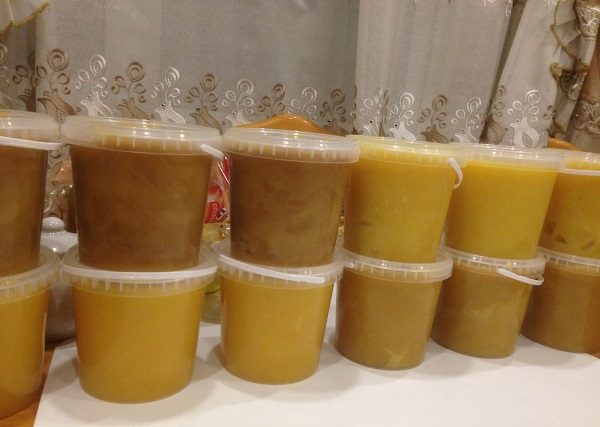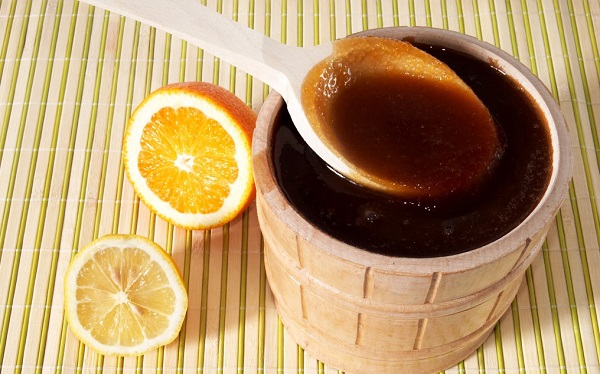Most honey names are derived from the honey plant that produces the product. Buckwheat is no exception. One of the favorite varieties, along with acacia and linden, is buckwheat honey. This is a high-grade and useful product. You can’t mix it up with any other color, especially.
In this article we will consider the beneficial properties and contraindications of buckwheat honey, let's talk about the benefits and medicinal properties.
Table of contents
Taste and color
Buckwheat honey is the darkest of all species. The color range is from red to dark brown.Compared with May it crystallizes faster, but the dark color is preserved. The aroma is delicate, the smell is pronounced, specific.
It seems bitter to taste. A distinctive feature of this type of honey is that after using it in the throat slightly tickle. This feature helps not to fall for a fake during its purchase in the market or store.
Ingredients: vitamins and minerals
Buckwheat honey is rich in easily digestible carbohydrates, in particular fructose. It has high acidity. Its composition is as follows:
| composition | % |
| fructose | 40 |
| glucose | 36 |
| water | 19 |
| polysaccharides | 8 |
| sucrose, ash, organic acids other substances | 7 |
Contains the following microelements:
- Manganese;
- Nickel;
- Chromium;
- Copper;
- Fluorine;
- Iron;
- Zinc and others.
Mineral substances are represented by salts:
- Sodium;
- Phosphorus;
- Calcium;
- Yoda;
- Gland.
In this honey, many essential amino acids.
100 grams of the product contains vitamin C (ascorbic acid) up to 65 mg, B group vitamins: B1 - 03 g, B2 - 0.4 g, B3 - 0.8 g, B5, B6, B9 (0.5 g), other vitamins.
In 100 gcontains 0.5 grams of protein, about 77 grams of carbohydrates.

Beneficial features
So what is good for buckwheat honey? Of the beneficial properties, we boldly note soothing and relaxing. In this regard, it is an excellent antidepressant.
This type is allowed to use diabetics only after consulting a doctor. It also has an antimicrobial effect. It contains a lot of enzymes, which contributes to the digestion of food. It is very nutritious (309 kilocalories per 100 g of product). He is able to remove radionuclides. To do this, in the morning on an empty stomach drink a glass of water and eat a tablespoon of honey. This natural product envelops the intestinal wall.
Contraindications and harm
Buckwheat honey is eaten in moderation. Excessive use of it causes metabolic disorders and allergies in even a healthy person. In general, it is quite a strong allergen, so people suffering from this disease should refuse to take it as food.
It is not recommended to give this type of honey to a child under three years old and people suffering from diabetes.. Every day an adult needs to eat 120-140 grams, for children - not more than 60 grams.
Honey lovers will be interested in:
- Application of bee venom in cosmetology and pharmacology.
- how apply propolis tincture at home?
- How to cook and Trepang honey treatment?
About honey plant
Everyone knows the beneficial properties of buckwheat. Buckwheat groats - the product that is purchased by the hostesses in the first place. Its cost is higher than others just because of its beneficial properties. Imagine that all this benefit is multiplied several times thanks to bees toilers. Buckwheat blooms in a month after germination.
The flowering period is long - about a month, but it all depends on the weather. Bees can collect nectar from buckwheat for a long time not only due to this. Buckwheat is sown early and later. Thus, the total collection period is extended to two months. Even if the bees could not produce enough honey from other plants, this honey plant helps us out.
But do not forget that such results are in good weather.This honey plant does not like heat and dryness. Bees willingly work with buckwheat in the morning when there is dew. This plant blooms in July, August and even September.
Therefore, it is possible to wait for favorable weather, but it is better to be safe, taking out the apiary to the places where, besides buckwheat, there are wild plants. From 1 hectare of buckwheat at the rate of work for 2 bee families, you can take up to 50 kg of honey.

Storage conditions
You can store bee products everywhere. The main thing is to observe the temperature, and the humidity was within the normal range. In addition, it is undesirable to hit the honey in direct sunlight.
Before the onset of crystallization, temperatures of 15–18 degrees of heat are maintained.. After - enough positive temperature in the region of 7 degrees. Humidity keep at 60%.
For long-term storage, glass jars are better suited. For short-term storage during transportation, sale on the market, others take plastic ware as well.
Medicinal properties of buckwheat honey
Buckwheat honey due to its composition with its moderate use normalizes metabolism in the body. Skin diseases can also be healed thanks to him, including healing wounds.
It is noteworthy that radiation sickness partially recedes under the influence of buckwheat honey. It helps to cure depression and the best work of the liver, kidneys, heart. These diseases are only part of what this honey helps to cope with.
Due to its specific taste, color and beneficial qualities it is a valuable natural product. It is used with pleasure to restore health and increase the overall tone of the body.

Bought in the Krasnodar region this year, buckwheat honey 2 jars, the taste is really an amateur with bitterness, and the color of honey really is not confused with another. I had stomach problems, so for prevention I take 1 teaspoon of honey in the morning on an empty stomach, and it also cleans the blood well and is good for the liver. He also very well soothes and sets up in a positive way), took a spoonful of honey before bed and sleep like a child.